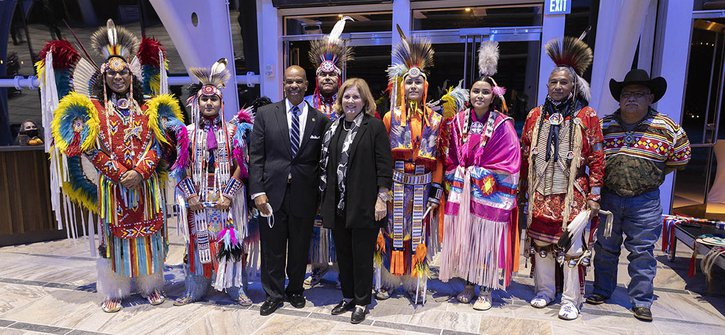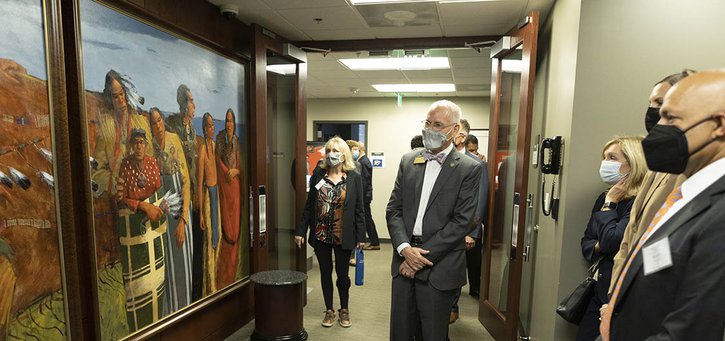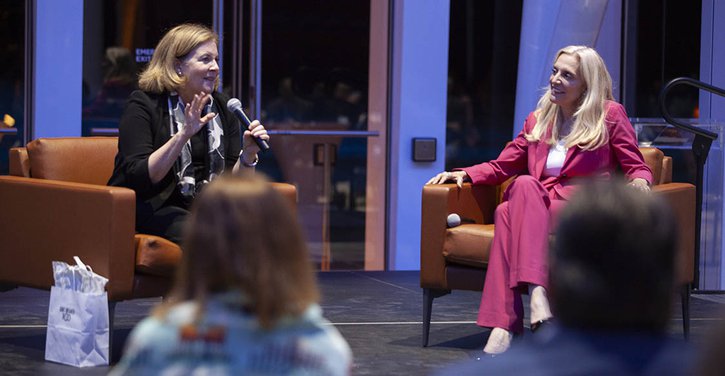Members of the Federal Reserve Bank of Kansas City’s four boards of directors gathered in mid-October in Oklahoma City for a joint meeting that was two years in the making.
The event—bringing together the boards for the bank’s Kansas City office, Denver Branch, Oklahoma City Branch and Omaha Branch—was planned for 2020 to mark the Oklahoma City office’s centennial but was rescheduled because of the coronavirus pandemic.

Edmond Johnson, Kansas City Board chair, with President Esther George and members of the Native American troupe known as the “Oklahoma Fancy Dancers.” Photo by Gary Barber
Directors assemble, learn about OKC’s growth
The joint board gathering included an Oklahoma City session of the “Fed Listens” series, which began in 2019 as a way for the Federal Reserve to directly hear how monetary policy affects peoples’ daily lives and livelihoods. The session was at the new First Americans Museum. The facility documents the collective histories of the 39 distinct First American Nations in Oklahoma today, which represent more than 60% of all enrolled Native Americans in the United States.
Under the Federal Reserve Act, each Reserve Bank is guided by a local board of directors, which comprises business and community leaders from the Reserve Bank’s region. At the Kansas City Fed’s headquarters, directors oversee the Bank’s operations and policies, and confer on economic and banking developments. Each of the Bank’s three branches also has a board of directors that provides insight on local economic conditions and advises the branch executives.
Each year, directors from all four offices gather in person at a single location. During this event, directors participate in board meetings and learn more about the Tenth District as a whole.
At the October meeting, board members heard from Mick Cornett, former mayor of Oklahoma City.
Cornett spoke about the city’s decades-long Metropolitan Area Projects (MAPS), a sales tax-funded public improvement effort that helped rejuvenate downtown. Cornett said the effort helped create a “big league” environment, noting that Oklahoma City is home to the Thunder, a National Basketball Association team.
Since 1993, dozens of projects have been completed to increase the quality of life for residents, including renovations to more than 70 schools. Initiatives included a new library, entertainment arena, fairground updates, construction of a riverfront, 70-acre public park and Bricktown Canal. Another MAPS phase is being developed by city officials, with plans to add 16 projects.
“We created a city where people wanted to live,” Cornett said. “We wanted to be healthy, more vibrant … a destination.”
Later, the directors toured the Oklahoma City National Memorial and Museum and heard from Cathy Keating, who was the first lady of Oklahoma at the time of the 1995 bombing of the Alfred P. Murrah Federal Building. Keating spoke about the bombing and the aftermath and provided a detailed account of the outpouring of support from Oklahoma citizens and across the country.

Directors toured the Oklahoma City Branch office, where “Cloud People,” a painting by Oklahoma artist Mike Larsen, is displayed. Larsen, who is Chickasaw, has said the painting depicts an Arapaho shaman’s protective cloak to memorialize the 1995 Oklahoma City bombing. Photo by Gary Barber
Recognizing Native American contributions
A unique opportunity for the joint board gathering was a tour and reception at the First Americans Museum. Construction of the museum started in 2006 and it opened in September. As part of its mission, the museum aims to “educate the broader public about the unique cultures, diversity, history, contributions, and resilience of the First American Nations in Oklahoma today.”
During the museum visit, directors attended a “Fed Listens” session titled “Engaging Tribal Leaders on Financial Inclusion and the Economic Challenges of the Pandemic.” Through the series, Federal Reserve officials meet with a broad range of individuals, households and communities to hear about their experiences during the recovery from the COVID-19 pandemic.
During the session, seven tribal leaders from across Oklahoma took the stage with Kansas City Fed President Esther George and Federal Reserve Governor Lael Brainard.
“I want to recognize the important economic contributions Native American communities are making, despite daunting impediments that were exacerbated by the COVID-19 pandemic,” Brainard said. “Once vaccines began to roll out in early 2021, tribal nations distributed them under a prioritized and phased timeline developed in accordance with Centers for Disease Control and Prevention guidance. This assistance from tribal nations helped make Oklahoma one of the top 10 states for vaccine rollout.”

President George joined Federal Reserve Governor Lael Brainard on stage at the First Americans Museum for a discussion with Kansas City Fed directors.
Discussing challenges
Throughout the session, leaders discussed the economic struggles for native communities. Some challenges were worsened by the pandemic, but many were present before COVID-19. Career readiness, barriers to higher education, lack of financial education, and inadequate access to banking resources and broadband service were some of the obstacles highlighted by the panel.
“Imagine a community without cell service,” Cherokee Nation Principal Chief Chuck Hoskin Jr. said. “It doesn’t seem possible today. But it happens in this country, and it happens in Indian Country.”
During the event, Brainard said the Federal Reserve Board had joined the Central Bank Network for Indigenous Inclusion, which will foster ongoing dialogue, research and education to raise awareness of economic and financial issues and opportunities.
FURTHER RESOURCES
- External LinkSee video of the full Fed Listens session.
- Learn more about the Kansas City Fed's Board of Directors.
